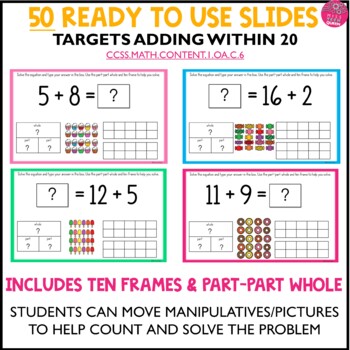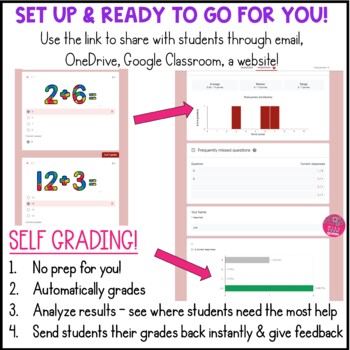Addition Problems Adding Activities Digital Math Practice Form Assessment BUNDLE
- Zip
- Google Apps™
- Microsoft OneDrive

Products in this Bundle (2)
Description
Go digital with this 50 slide activity & self assessment form. Students will practice adding within 20 using the part-part whole and ten frame method. The movable dessert themed manipulatives will help students count and solve. Then assess student using the self-grading form!
Why Use a Form?
1.SELF GRADING!
2.No prep for you!
3.Automatically grades
4.Analyze results - see where students need the most help & save data
5.Send students their grades back instantly & give feedback
The responses will be sorted into charts for quick view, or open to a spread sheet for a detailed view. It is quick and simple to use. Great for distance learning!
Included in This Resource:
- Adding within 20 Self Assessment
- 3 Forms
- 10 questions each
- Fun brick themed numbers
- Teacher's guide to using Forms
- Step by step instructions on how to use the file
- How to share with students
- How to edit questions
- How to view responses
- How to grade
- Adding within 20 Slides Activity
- 50 Ready to use problems
- Includes part-part whole chart
- Includes ten frame chart
- Includes dessert themed movable manipulative (ice cream, donuts, lollipops, cupcakes, ice pops, cake)
- Target CCSS.MATH.CONTENT.1.OA.C.6
- Teacher's guide to sharing on Google
- Step by step instructions on how to use the file for each program
- Two blank sides to add teacher directions to the students
- Digital manipulatives are included to create interactive slides. Students can drag & drop photos.
You must have a Google account to open this file. You will receive the link in the PDF file.
Click here to follow me & learn when new products are uploaded . New items are 50% off for the first 24 hours! :D
I'd love to hear your feedback :) When you review, you earn TPT credits for free purchases!
I'd Love to connect with YOU! Click here to follow me on Instagram
As always, please contact me with any questions! Thank you,
Dena





